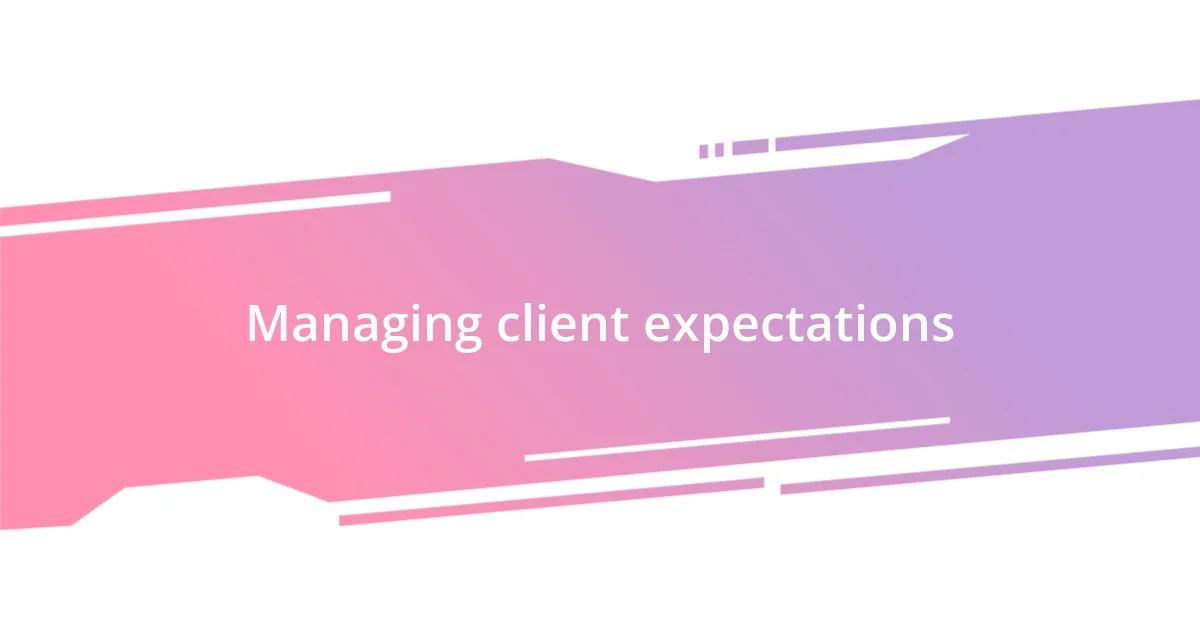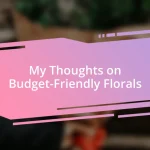Key takeaways:
- Understanding client emotions and personal stories is essential for creating meaningful floral arrangements that resonate deeply.
- Effective communication, including active listening and feedback, fosters a collaborative environment and ensures client satisfaction throughout the design process.
- Following up after delivery builds trust, allows for gathering valuable feedback, and enhances future creative endeavors through client insights.

Understanding client floral needs
When I first started working with clients, I quickly learned that understanding their floral needs was more than just taking an order. For instance, I once had a client who wanted flowers for their grandmother’s memorial service. It was essential to grasp not only the types of flowers she liked but also the emotions tied to the event. Wasn’t this about honoring a cherished memory? That insight transformed how I approached my design choices.
Sometimes, clients come to me with a specific vision in mind, but they struggle to articulate it clearly. I recall a young bride who was unsure about her color palette and floral arrangements. By asking open-ended questions and sharing my experiences, I helped her find clarity in what she truly wanted. This interaction made me realize how crucial it is to create a comfortable space where clients feel they can express their emotions and ideas.
In essence, understanding a client’s floral needs goes beyond logistics; it taps into their stories and emotions. Have you ever thought about how a single blossom can evoke memories from a wedding or a springtime garden? I’ve discovered that each request is a unique moment, allowing me to blend their personal narratives with my floral expertise, making the final arrangement not just a visual treat, but a heartfelt tribute.

Analyzing floral request details
When analyzing floral request details, I often start by carefully reviewing any specific instructions provided by my clients. Recently, a customer reached out with a request for a birthday surprise; they mentioned love for sunflowers and held memories of golden fields from their youth. These small details matter because they help me connect the flowers to personal stories, making the arrangement more meaningful.
In addition to the flowers themselves, I pay attention to practical aspects like the event’s location and the overall theme. I remember a corporate event where the client desired a sophisticated look but wanted to maintain a warm and inviting atmosphere. This inspired me to blend deep reds with soft creams, balancing elegance with approachability, which resonated wonderfully with the attendees.
Each floral request is like a puzzle, piecing together emotions and specifics. I’m always intrigued by how a single choice, such as opting for peonies over roses, can reflect a client’s personality. How often has a particular bloom struck a chord with someone? It’s these insights that shape my approach, ensuring that every arrangement is not just beautiful but also a reflection of the client’s essence.
| Detail to Analyze | Importance |
|---|---|
| Client’s Emotional Connection | Helps to personalize the arrangement, making it meaningful. |
| Specific Requests | Guides the selection of flowers and colors, ensuring satisfaction. |
| Event Details | Informs the style and presentation, aligning with the overall theme. |
| Practical Considerations | Ensures the arrangement suits the venue and context, enhancing visual impact. |

Communicating effectively with clients
When I engage with clients about floral arrangements, clear communication is key. I’ve found that utilizing active listening techniques makes a world of difference. For instance, during a recent consultation, a man wanted flowers for his partner’s anniversary. As he spoke, I made sure to repeat key points back to him, confirming his desires and feelings. This not only reassured him that I understood but also led to discovering little details—like their first date being a picnic in a rose garden—that shaped the entire design.
Here’s how I ensure effective communication with clients:
- Ask Open-Ended Questions: This encourages clients to express their feelings and preferences fully.
- Summarize and Clarify: Briefly paraphrasing what clients say assures them I’ve grasped their vision.
- Share Personal Experiences: Relating similar past projects can foster trust and inspire new ideas.
- Encourage Feedback: Inviting clients to share their thoughts during the process ensures they feel heard and valued.
By taking these steps, I create an atmosphere where clients feel comfortable sharing their heartfelt stories, enriching our collaboration.

Offering personalized floral solutions
When it comes to offering personalized floral solutions, I truly believe that understanding the client’s vision goes beyond the conventional request. I once had a bride who envisioned a garden of wildflowers for her rustic wedding. As we talked, she shared her love story, which blossomed in similar fields during their summer getaways. This insight sparked the idea of incorporating not just flowers but also elements that evoked those serene moments, transforming the bouquet into a narrative rather than just an arrangement.
I find joy in tailoring selections that reflect the essence of each client. For example, a recent client wanted blossoms for a housewarming gift. Instead of the usual go-to options, I asked about her favorite colors and how she’d like the flowers to complement her home decor. This conversation revealed her fondness for cool blues, which allowed me to curate a stunning combination of hydrangeas and delphiniums that perfectly matched her aesthetic. Isn’t it fascinating how a simple dialogue can inspire creativity?
The magic often lies in the details. I remember working with a client who had specific preferences for fragrance; she wanted the arrangement to enhance her living space and uplift her mood. Based on her love for lavender and eucalyptus, we crafted something both visually breathtaking and aromatic. In my experience, these personalized touches not only create beautiful floral pieces but also foster deep connections with clients, making each arrangement a unique expression of them. What more could I ask for than to bring joy through flowers?

Managing client expectations
Managing client expectations is a delicate dance that can truly affect the outcome of any floral project. I always start by setting realistic timelines and clearly outlining what can be achieved within those constraints. For instance, when a recent client expressed urgency for a vibrant arrangement on a tight deadline, I candidly discussed my workflow and how we could maximize efficiency without compromising quality. This approach not only eased her anxiety but also built trust, knowing that I was committed to delivering what she envisioned, even within a limited timeframe.
One key aspect of managing expectations lies in visual aids. I often find that showing photos of previous work can help clients visualize the possibilities, thereby aligning their expectations with what’s feasible. While working with a couple planning their wedding, I used a portfolio of similar arrangements to guide our conversation. It was enlightening to see their excitement grow as they narrowed in on colors and styles, but I also made sure to highlight any limitations. By sharing the potential challenges, like seasonal flower availability, I empowered them to make informed decisions while keeping their dreams intact. Isn’t it amazing how a simple image can bridge the gap between expectation and reality?
Ultimately, I believe in fostering an ongoing dialogue throughout the process. Regular check-ins can catch any shifts in the client’s vision early on. I recall a time when a client initially wanted a romantic cascade bouquet, but halfway through, she expressed a newfound love for modern, structured designs. Instead of waiting for the delivery day to reveal the final arrangement, we adjusted course together, embracing her evolving preferences. Does that level of engagement not turn the creative process into a collaborative journey, making the final result even more meaningful for the client?

Following up after delivery
After I deliver a floral arrangement, I always make it a point to follow up with my clients. This simple gesture not only shows that I care about their satisfaction, but it also opens the door for valuable feedback. I remember a time when I delivered a centerpiece for a corporate event. After checking in, I learned that the arrangement received numerous compliments, which filled me with pride. Isn’t it rewarding to know your work brings joy to others?
I encourage clients to share their thoughts and any unexpected moments that arose from the arrangements. For instance, after delivering a bridal bouquet, one bride told me it sparked an impromptu photo session with her friends, making a fun memory they’ll cherish forever. Hearing these stories not only enriches my understanding of how my work impacts their lives but also enhances my creativity for future projects. Shouldn’t every floral delivery be a chance to create lasting connections?
Following up also allows me to address any concerns my clients might have. I distinctly recall a situation where a client mentioned that a specific flower in the arrangement wilted faster than expected. Instead of just offering apologies, I provided advice on how to care for the flowers effectively at home. This not only resolved her concern but also showcased my commitment to her experience. Isn’t that a wonderful opportunity to reinforce trust and loyalty?

Gathering client feedback for improvement
Gathering client feedback is a crucial part of my process, and I’ve found that it often leads to unexpected insights. Recently, I asked a client about her experience with a birthday arrangement I created. She mentioned that the scent of the flowers sparked joyful memories of celebrations from her childhood. This feedback not only warmed my heart but also opened my eyes to how important olfactory elements can be in floral design. Isn’t it fascinating how flowers carry stories?
I also value feedback during my creative process. For instance, I once collaborated with a client for an anniversary surprise. Midway through crafting their arrangement, I checked in to see if the flowers still resonated with her vision. She revealed a newfound love for lilacs, which weren’t initially part of our discussion. By embracing her feedback, I was able to incorporate those lilacs, resulting in an arrangement that exceeded her expectations. How often do we overlook the evolving nature of our preferences?
Lastly, I always aim to create a safe space for constructive criticism. I recall a client who, after receiving her wedding bouquet, shared her thoughts about the color palette. While initially tough to hear, I appreciated her honesty and discovered new ways to enhance my designs. That conversation not only refined my artistic approach but also solidified our relationship. Isn’t it empowering when we can turn feedback into growth?














